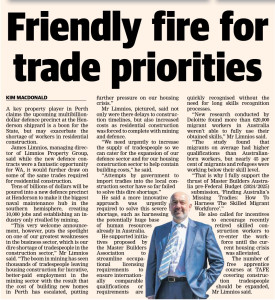By Kim Macdonald – The West Australian

A key property player in Perth claims the upcoming multibillion-dollar defence precinct at the Henderson shipyard is a boon for the State, but may exacerbate the shortage of workers in residential construction.
James Limnios, managing director of Limnios Property Group, said while the new defence contracts were a fantastic opportunity for WA, it would further draw on some of the same trades required for residential construction.
Tens of billions of dollars will be poured into a new defence precinct at Henderson to make it the biggest naval maintenance hub in the southern hemisphere, creating 10,000 jobs and establishing an industry only rivalled by mining.
“This very welcome announcement, however, puts the spotlight on one of our greatest weaknesses in the business sector, which is our dire shortage of tradespeople in the construction sector,” Mr Limnios said. “The boom in mining has seen thousands of tradespeople leaving housing construction for lucrative, better-paid employment in the mining sector with the result that the cost of building new homes in Perth has escalated, putting further pressure on our housing crisis.”
Mr Limnios, pictured, said not only were there delays to construction timelines, but also increased costs as residential construction was forced to compete with mining and defence.
“We need urgently to increase the supply of tradespeople so we can cater for the expansion of our defence sector and for our housing construction sector to help contain building costs,” he said.
“Attempts by government to import tradies into the local construction sector have so far failed to solve this dire shortage.”
He said a more innovative approach was urgently required to solve this severe shortage, such as harnessing the potentially huge base of human resources already in Australia.
He supported initiatives proposed by the Master Builders Association to streamline occupational licensing requirements to ensure internationally comparable qualifications or requirements are quickly recognised without the need for long skills recognition processes.
“New research conducted by Deloitte found more than 620,000 migrant workers in Australia weren’t able to fully use their obtained skills,” Mr Limnios said.
“The study found that migrants on average had higher qualifications than Australian-born workers, but nearly 45 percent of migrants and refugees were working below their skill level.
“That is why I fully support the thrust of Master Builders Australia pre-Federal Budget (2024/2025) submission, ‘Finding Australia’s Missing Tradies: How To Harness The Skilled Migrant Workforce’.”
He also called for incentives to encourage recently retired skilled construction workers to re-enter the workforce until the current housing crisis was alleviated.
The number of apprentice courses at TAFE covering construction tradespeople should be expanded, Mr Limnios said.



